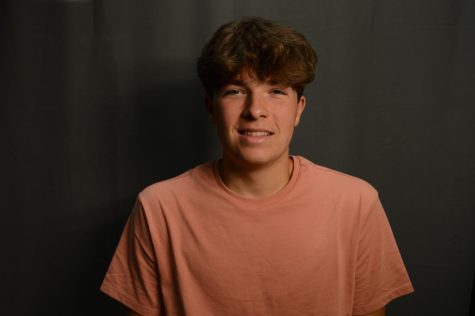Next level athletes: A look into the recruiting process of student athletes

Photo by Provided by Aidan Biddle
February 27, 2023
Sitting in the open gym, Senior Aidan Biddle was facing the biggest decision of his life. In front of him lay a pen and piece of paper on an empty desk. That single sheet potentially mapped out his future for the next four years. What was on that page? A national letter of intent to swim at Ball State University. Surrounded by his coaches and the people he loves, the senior All-State swimmer took a deep breath, picked up the pen and did what he’s done so many times before. He smiled for the camera…
In Noblesville’s recent run of state championships, in boys and girls soccer and girls cross country, the number of student-athletes committing to play sports at the collegiate level has climbed dramatically. From inside Indiana to around the midwest to up and down the East Coast, Noblesville athletes will compete at dozens of colleges in the upcoming year. If you are not a highly-recruited athlete, this process of committing to a college can often be a mystery, though it’s a practice that involves a constant stream of communication between coaches and recruits. This is how the recruiting process began for Junior Riley Resmer, a trail that eventually ended with her committing to Harvard for volleyball.
“A couple of schools would text me throughout the week asking for updates or to send me information, but the majority wanted to set up a call once every one or two weeks to catch up,” Resmer said.
Communication in the form of text messages or phone calls is usually the first step in the recruiting process for both players and coaches. This communication allows coaches and athletes to know each other and for the recruit to feel welcomed by the school. Biddle points out that the amount of contact from a school is unique to each athlete.
“Some colleges did try to chase me a little bit. There were some smaller schools who would email me a lot and even some who would find me at meets consistently,” Biddle said. “One school even sent me an email after I committed, guilt-tripping me for not picking their school.”
Though schools often contact recruits online, in-person communication is usually vital for coaches and athletes alike. This can be a time for coaches to see the athletes play in-person and determine if the school’s recruiting tapes match what they see with their own eyes.
“A lot of schools are really active before camps so that a lot of girls come and they can see what they’re like in the gym, work with them one on one, and decide if they’re a good fit,” Resmer said. “After camps, everything slows down because coaches start to focus on the girls they are most interested in and liked the most at camp.”
High school coaches have a front row seat for the recruiting process, and after a few years of experience, many coaches can immediately tell the difference between a scout and can point out a scout from the normal fan.
“On occasion, we’ll have coaches from local colleges come to our games to watch a specific player. But in our sport, colleges do more recruiting of players during their club season, because they’re able to see more players at one time,” varsity girls soccer head coach Mike Brady said. “College coaches do reach out to me, but usually it’s more to discuss the player’s character than it is to discuss her playing ability.”
In most cases, the next step in the recruiting process is an in-person visit to a college. These are a school’s chance to show off their facilities and impress each athlete with why they would do best at their college. These trips can range from a single-day trip to a weekend stay, and the agenda for the trip is unique to each college. For senior softball player Erin Clark, she set aside time during her visits to investigate the academic resources of the colleges she visited, and she eventually landed on Butler as the best fit for her.
“Being able to visit many different schools was such an amazing opportunity. It was very cool to see all of the different campuses and academic and athletic programs at each. It was also very interesting to be able to see all of the different cultures among the different schools,” Clark said.
College visits can be official or unofficial. Visits that are considered official allow for the college the student and go all-out for recruits. Unofficial visits require the recruit to pay their own way.
“Official visits are really fun. I stayed in the dorms with the players, went to class with them, ate all the team meals, sat in the locker room with the girls, watched their pregame film sessions, and went to a water polo match,” Resmer said. “They paid for my flights and all of my food while I was there.”
These visits can be set up in a variety of ways, from more formal tours of the college or even including extracurricular activities that give athletes a glimpse of what college life can be.
“The group of athletes I was with got free meals for two-and-a-half days, including a steak dinner that the coach hosted. We also went bowling, played games at their football field, went out for ice cream, and toured all of their facilities free of charge,” Biddle said. “We also got to spend the majority of the time with the team there so we could get the most raw, natural experience of what the team is like.”
Many recruits also consider a school’s academic setting and judge how well the college can provide for them in their studies along with athletics.
“I was between Butler and another school, so I chose to sign up for an academic visit so I could see more of the academic buildings on campus. After that visit is when I ultimately made my decision to go to Butler,” Clark said.
The final step in the recruiting process is the big one: deciding where to attend. This can be stressful for athletes as they narrow down their options and set their mind on one school while telling the others that they will not go there.
Once recruits commit, the process is close to finished. Like Biddle experienced on his big day in December, a recruit’s final task ends with a signature on their national letter of intent, when an athlete goes from a recruit to a signee. After this, the athletes are free to post their decisions and release the recruiting trail stress.
“Everyone was so encouraging and exciting for me, it was really great. My whole family cried, I got so many texts congratulating me, and a couple of the girls I stayed with on my visit reached out too,” Resmer said.
“It was such an amazing experience because it felt like a weight had been lifted off of my shoulders,” Clark said. “I had spent a lot of effort throughout my recruiting process in order to achieve the goal of going to an amazing school, and getting the opportunity of playing softball was a bonus.”




